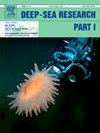Ecopath modelling Unravels the food web of the Gulf of Corinth, a deep Mediterranean important marine Mammal area
IF 2.1
3区 地球科学
Q2 OCEANOGRAPHY
Deep-Sea Research Part I-Oceanographic Research Papers
Pub Date : 2025-02-15
DOI:10.1016/j.dsr.2025.104466
引用次数: 0
Abstract
The Mediterranean Sea, recognized as a biodiversity hotspot, is facing significant impacts from human-induced stressors such as overfishing and climate change, which exert pressure on its ecosystems. The Gulf of Corinth (eastern Mediterranean Sea, Greece) encompasses a deep ecosystem that has not been extensively studied, despite its rich biodiversity and the presence of Protected, Endangered, and Threatened (PET) species. An Ecopath trophic model was implemented for the baseline period 2014–2016 to outline its ecological structure, with special emphasis on (i) dolphins (bottlenose, striped, and common) and other PET species, as the Gulf is an Important Marine Mammal Area; (ii) deep-living groups such as mesopelagic fishes, due to their wide distribution and high abundance; and (iii) commercial species to assess the impact of fishing. Model outputs reveal a complex food web structure with numerous links among functional groups, with detritus serving as dominating energy source, particularly in the pelagic zone. Dominant species, such as mesozooplankton, and keystone species, including squid, sharks, and hake, shape the trophic relationships in the water column, with keystone prey groups such as shrimps and mesopelagic fish contributing significantly. Model statistics align with those of other modeled ecosystems in Greece, consistent with productivity patterns and other ecological features; however, ecological indicators suggest a relatively immature ecosystem state despite low fishing pressure. Due to spatio-temporal bans on semi-industrial fisheries and the absence of extensive suitable trawling grounds and small pelagic fish populations, small-scale fisheries exert the highest fishing pressure. The estimated probability of sustainable fisheries in the ecosystem is high (estimated at 94%), while trophic competition among fisheries and PET species is moderate to low, with the exception of bottlenose dolphins. The model was developed to enhance understanding of species trophic relationships and energy flows in the system, making it a critical tool for effective management and conservation initiatives in the Gulf of Corinth.
生态模型揭示了科林斯湾的食物网,一个深地中海重要的海洋哺乳动物区
作为生物多样性的热点地区,地中海正面临着过度捕捞和气候变化等人为压力因素对其生态系统造成的重大影响。科林斯湾(希腊地中海东部)包含一个深层生态系统,尽管其生物多样性丰富,存在受保护、濒危和受威胁(PET)物种,但尚未得到广泛研究。在2014-2016年的基线期间实施了生态营养模型,以概述其生态结构,特别强调(i)海豚(宽吻海豚,条纹海豚和普通海豚)和其他PET物种,因为海湾是重要的海洋哺乳动物区;(ii)深海鱼类,例如中远洋鱼类,因为它们分布广泛,数量众多;(三)商业物种评估捕捞的影响。模型结果揭示了一个复杂的食物网结构,在功能群之间有许多联系,碎屑是主要的能量来源,特别是在远洋区。优势物种,如中浮游动物,和关键物种,包括鱿鱼、鲨鱼和鳕鱼,塑造了水柱中的营养关系,关键猎物群体,如虾和中远洋鱼类贡献显著。模型统计数据与希腊其他生态系统模型统计数据一致,与生产力模式和其他生态特征一致;然而,生态指标表明,尽管捕捞压力较低,但生态系统处于相对不成熟的状态。由于半工业化渔业的时空禁令,以及缺乏广泛的合适拖网渔场和小型远洋鱼类种群,小规模渔业施加的捕捞压力最大。生态系统中可持续渔业的估计概率很高(估计为94%),而渔业和PET物种之间的营养竞争是中等到低的,宽吻海豚除外。该模型的建立是为了加强对物种营养关系和系统能量流动的理解,使其成为科林斯湾有效管理和保护举措的关键工具。
本文章由计算机程序翻译,如有差异,请以英文原文为准。
求助全文
约1分钟内获得全文
求助全文
来源期刊
CiteScore
4.60
自引率
4.20%
发文量
144
审稿时长
18.3 weeks
期刊介绍:
Deep-Sea Research Part I: Oceanographic Research Papers is devoted to the publication of the results of original scientific research, including theoretical work of evident oceanographic applicability; and the solution of instrumental or methodological problems with evidence of successful use. The journal is distinguished by its interdisciplinary nature and its breadth, covering the geological, physical, chemical and biological aspects of the ocean and its boundaries with the sea floor and the atmosphere. In addition to regular "Research Papers" and "Instruments and Methods" papers, briefer communications may be published as "Notes". Supplemental matter, such as extensive data tables or graphs and multimedia content, may be published as electronic appendices.

 求助内容:
求助内容: 应助结果提醒方式:
应助结果提醒方式:


